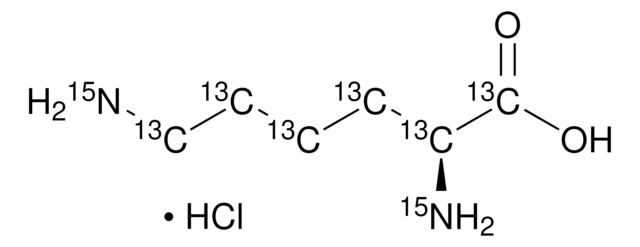Wichtige Dokumente
L9037
L-Lysin Monohydrat
98.5-101.5% dry basis, suitable for cell culture, BioReagent, non-animal source
Synonym(e):
L-Lysine hydrate (1:1), Lysine monohydrate
About This Item
Empfohlene Produkte
Produktbezeichnung
L-Lysin Monohydrat, BioReagent, suitable for cell culture, from non-animal source
Biologische Quelle
non-animal source
Qualitätsniveau
Produktlinie
BioReagent
Assay
98.5-101.5% dry basis
Form
crystalline powder
Methode(n)
cell culture | mammalian: suitable
Verunreinigungen
endotoxin, tested
Farbe
white
mp (Schmelzpunkt)
215 °C
Löslichkeit
H2O: soluble
SMILES String
[H]O[H].NCCCC[C@H](N)C(O)=O
InChI
1S/C6H14N2O2.H2O/c7-4-2-1-3-5(8)6(9)10;/h5H,1-4,7-8H2,(H,9,10);1H2/t5-;/m0./s1
InChIKey
HZRUTVAFDWTKGD-JEDNCBNOSA-N
Suchen Sie nach ähnlichen Produkten? Aufrufen Leitfaden zum Produktvergleich
Allgemeine Beschreibung
Anwendung
- bei der SILAC-Methode (SILAC: Stable Isotope Labeling by Amino Acids in Cell Culture)
- im vollständigen synthetischen (C-)Medium für positives Selektionsscreening von Hefezellen
- im Nährmedium für Zellen
Biochem./physiol. Wirkung
Lagerklassenschlüssel
11 - Combustible Solids
WGK
WGK 1
Flammpunkt (°F)
Not applicable
Flammpunkt (°C)
Not applicable
Persönliche Schutzausrüstung
Eyeshields, Gloves, type N95 (US)
Hier finden Sie alle aktuellen Versionen:
Besitzen Sie dieses Produkt bereits?
In der Dokumentenbibliothek finden Sie die Dokumentation zu den Produkten, die Sie kürzlich erworben haben.
Kunden haben sich ebenfalls angesehen
Unser Team von Wissenschaftlern verfügt über Erfahrung in allen Forschungsbereichen einschließlich Life Science, Materialwissenschaften, chemischer Synthese, Chromatographie, Analytik und vielen mehr..
Setzen Sie sich mit dem technischen Dienst in Verbindung.








